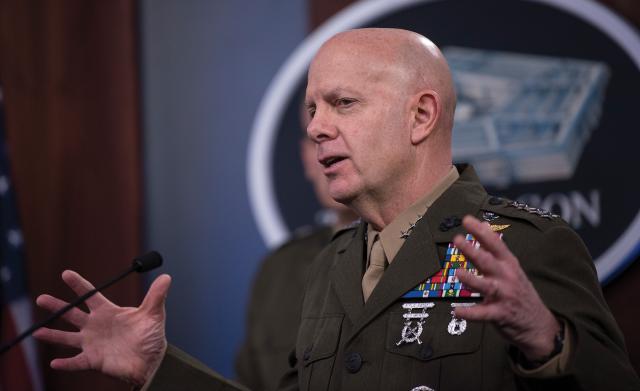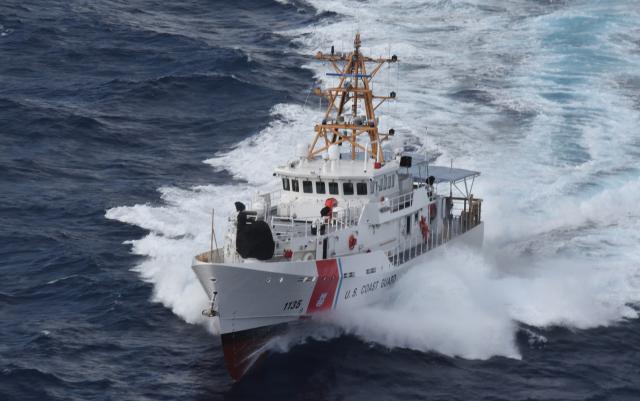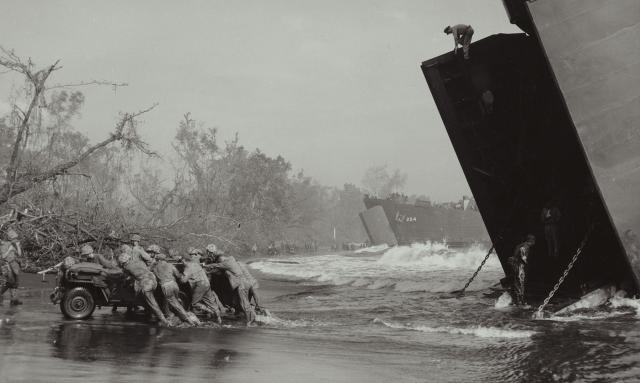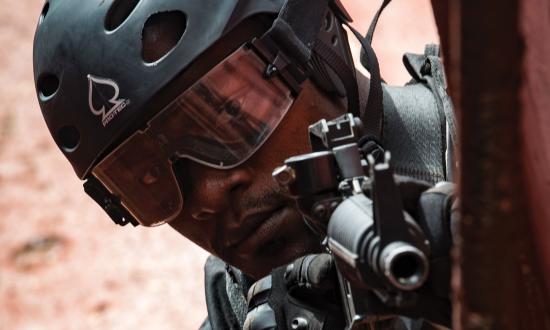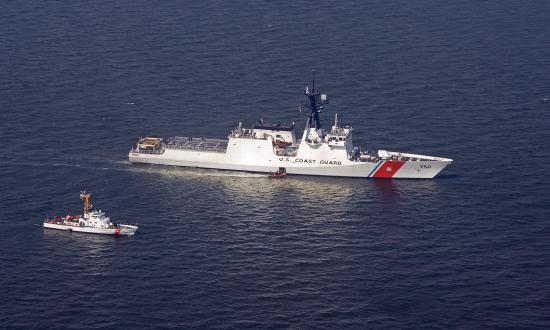The next great power conflict probably will be fought in the Pacific islands—dispersed, mobile, and inside China’s weapons engagement zone. U.S. Marines will vie to seize or hold island bastions to contain China’s expansion with long-range, land-based missiles, while a hull-starved U.S. Navy attempts to maintain open lines of communication.1 To win, the joint force will need local superiority in the littorals provided by inexpensive, expertly crewed, risk-worthy combatants that punch above their weight. That is a job for Coast Guard patrol boats (WPBs).
The Next War
In Force Design 2030 (FD2030), Commandant of the Marine Corps General David H. Berger identifies how the Marine Corps, along with the Navy must adapt for the next war. His plan describes a lighter Marine Corps, divested of heavy assets such as armor and tube artillery, which have become vulnerable to long-range fires and smart weapons. It states that forward bases will be easily targeted, range and operational reach are vital in the Indo-Pacific region, and the ability to maintain combat operations inside China’s weapons engagement zone—under accurate fire at range—will be a “critical advantage and an operational imperative.”2
Critically, General Berger writes that attrition will be unavoidable, and the “stand-in” forces capable of “technically disruptive, tactical stand-in engagements that confront aggressor naval forces with an array of low signature, affordable, and risk-worthy platforms and payloads” will be decisive.3 FD2030 does not mention the Coast Guard. This is notable because it contemplates the future of coastal/riverine forces, the employment of mine countermeasures, and the critical vulnerability presented by logistics. Historically, coastal warfare, minesweeper defense, and protecting friendly seaborne logistics and interdicting those of the enemy are Coast Guard combat missions. Today, the manning and experience needed to carry them out rests almost exclusively within the Coast Guard.
FD2030 points out that “the Marine Corps must be able to fight at sea, from the sea, and from the land to the sea; operate and persist within range of adversary long-range fires; maneuver across the seaward and landward portions of complex littorals” (emphasis added).4 The “seaward and landward portion of complex littorals,” more commonly known as “the coast,” is where Coast Guard WPBs excel. The next Pacific war will be a maritime fight that requires all three Sea Services working in concert. That interoperability needs to start now.
Different but Not New
The concept of distributing garrisons on Pacific islands is not new. World War II included notable instances of small garrisons fighting off advancing forces, as the United States did in 1941 when Japan invaded the Philippines, and as Japanese forces did when the Marines advanced through Guadalcanal and Leyte. PT boats—the World War II analog to modern WPBs—scored some of the first U.S. victories over Japan while supporting a fighting retreat in the Philippines. They supported troops ashore and scored asymmetric kills on much larger opponents.5 PT boats also interdicted Japanese attempts at resupplying forward garrisons.
Technology has changed since the days of the PT boat, but geography has not. Distributed island forces need resupply by sea, and in the constrained waters of the Pacific islands, heavily armed patrol craft can punch well above their weight. The same changes in precision fires that have made war in the littorals more difficult have increased the potency of WPBs, while making it harder for larger, more expensive combatants to survive.
Optimal for Coastal Warfare
If FD2030 is a guide, the next war will indeed need risk-worthy patrol boats. Fortunately, the Coast Guard has the boats, experience, and people to win that war.
The Boats
The Sentinel-class fast response cutter (FRC) is ideal for Pacific island warfare. Boasting a small crew, a long 2,500-nm range, robust seakeeping ability for its size, and ample room for increased armament, the FRC is suited to fill the gap between small combatants such as the Navy’s Mark VI patrol boat (PB), and larger ones such as the littoral combat ship (LCS).
Fifty-eight U.S.-based FRCs are planned, with six additional being built for Coast Guard Patrol Forces Southwest Asia to replace the aging Island-class boats that have patrolled the Arabian Gulf under Destroyer Squadron (DesRon) 50 since 2003.6 At $65 million per hull and with an open production line, the FRC provides a relatively low-cost, high-volume means of increasing U.S. combat power in the littorals.7
Capable of independent deployment, and with state-of-the-art command-and-control systems, the FRC has the range and technical sophistication to operate in the expanse of the Pacific. The FRC’s long range can be extended by refueling at sea from Navy oilers, destroyers, or larger Coast Guard cutters.8 What’s more, it can refuel smaller combatants, such as riverine command boats, enabling combat operations closer inshore or upriver.
The FRC also carries a 25.5-foot-long, 8.5-foot-wide, 7,500-pound cutter boat over-the-horizon rigid-hull inflatable boat.9 It is equipped with radar and advanced communications and can operate independently “over the horizon” from the cutter, making it well-suited for supporting distributed operations in the littorals. More important, it is carried in a commodious stern launch that could accommodate the launch and recovery of relatively large unmanned surface vessels (USVs) or unmanned underwater vehicles to conduct intelligence, surveillance, and reconnaissance (ISR) or kinetic action in support of the Commandant’s directive to provide “technically disruptive, tactical stand-in engagements that confront aggressor naval forces with an array of low signature, affordable, and risk-worthy platforms and payloads.”10 Moreover, the ample deck space on the FRC could support the launch and recovery of light unmanned aerial systems (UASs).
The FRC’s armament of a 25-mm machine gun, plus four .50-caliber machine guns, is too light for “stand-in” combat. Upgunning the FRC with additional machine guns—as was done to WPBs in Vietnam and Operation Iraqi Freedom—will be necessary but insufficient. To persist as part of the Commandant’s “stand-in” forces, the FRC needs a limited electronic warfare capability and an antiair and antisurface point-defense capability. There is ample deck space to outfit the FRC with the FIM-92 Stinger surface-to-air missile and the laser-guided AGM-176 Griffin carried on board the comparably sized Navy Cyclone class.11 However, to answer the Commandant’s demand for “long-range, precision expeditionary antiship missile fires,” the FRC needs an offensive punch in the form of cooperative engagement capability and modern missiles.12 This would allow FRCs to share and act on targeting data from other manned or unmanned assets. The addition of antiship cruise missiles would give the FRC the ability to sink a major combatant at range in an asymmetric engagement.
The Naval Strike Missile (NSM), with a greater than 100-nm range, can be mounted in configurations ranging from one to six missiles depending on the available space, and the FRC likely could fit several on its forward deck. Should stability or structural limitations prevent placement on the high forward deck, there is room on the stern. A quadmount of NSMs weighs 8,600 pounds, including electronics and cabling, and could replace the rigid-hull inflatable boat on the FRC’s stern with a minimal impact on weight and stability.13
Ultimately, the FRC has the range and endurance to fight in the Pacific, a capable rigid-hull inflatable boat to support inshore operations, the payload capacity to carry a variety of unmanned systems, and the space for powerful weapons that could level the playing field inside China’s weapons engagement zone.
Experience and People
Coast Guard patrol boat experience provides a competitive advantage in the littorals. In Vietnam, WPBs interdicted maritime traffic along the coast and provided support to troops ashore with machine-gun and mortar fire. WPBs again participated in Operation Iraqi Freedom, escorting—and even patrolling ahead of—minesweepers.14 Since 2003, WPBs have squared off against terrorists and the Islamic Revolutionary Guard Corps Navy, shielding U.S. assets from harassment or attack.15 Seventeen years of continuous operations in the Arabian Gulf have generated a deep bench of officers and enlisted members with surface warfare experience.
Coast Guard navigation expertise also will pay dividends in the littorals, where navigation problems come fast and the environment is unforgiving. Coastal navigation involves different skills from blue-water navigation, skills that Coast Guard WPB and small-boat crews practice every day. These navigation challenges will be compounded if China disrupts the electromagnetic spectrum, degrading GPS and communications signals. The effect of spoofed or denied GPS signals on patrol boats moving inshore at high speed at night could be severe. However, Coast Guard strengths in coastal piloting will afford patrol boat crews the best chance of success in the coastal environment.
What’s more, Coast Guard law enforcement experience lends itself to coastal interdiction and combat. Narrow straits limit maneuver, indented coastlines provide places to hide, and nonmilitary traffic clutters the battlespace—even in wartime. The Coast Guard is good at finding those who do not want to be found and is great at quickly distinguishing innocent from nefarious vessel traffic by eye.
Coast Guard manning also contributes to its competitive advantage by building years of experience that cannot be developed once a war breaks out. Coast Guard officers see command opportunities as early as O-2 and, from ensign to admiral, are familiar with employing WPBs in the littorals during combat, law enforcement, or search-and-rescue operations. What’s more, enlisted members can spend a career alternating between patrol boats and assignments at small-boat stations, where they master law enforcement and search-and-rescue operations closer to shore. Some of those members go on to command patrol boats. This deep bench of officers and enlisted members would allow patrol boats to navigate effectively and act independently in a Pacific war.
Employing Coast Guard Patrol Boats
Forward in Harm’s Way
Optimally, patrol boats would be based forward and deployed in harm’s way, using their range and augmented armament to provide an asymmetric counterweight against China. With antiship missiles, cooperative engagement capability, and UASs, patrol boats could hunt Chinese surface ships while hiding in the lee of islands, increasing the salvo capacity of an undersized U.S. Navy. Conversely, they could employ core Coast Guard interdiction competencies to destroy attempts at infiltration or resupply by small craft or USVs, or provide high-value asset escort to screen minesweepers or large combatants. Ultimately, putting patrol boats downrange will take the strain off expensive, heavily crewed assets that can take months or years to repair when damaged, even in peacetime.16 Missile-armed patrol boats could provide the sort of “risk-worthy platform” that would allow the joint force “to absorb loss and continue to operate decisively.”17
White Hulls in Gray Zones
Coast Guard patrol boats can take the strain off of high-end ships in other ways as well. Great power competition also manifests in “gray zone” conflicts short of war, or in low-intensity proxy wars. Such conflicts do not require high-end warships and can be prosecuted at a lower cost by patrol boats, either through “gray zone” presence operations or proxy war combat. The latter likely will occur as China or Russia seeks to tie U.S. forces down in a proxy war in the Arabian Gulf, Indo-Pacific, and Mediterranean or Baltic seas.
Command, Control, and Logistics
A successful model for joint Sea Service operations already exists. Coast Guard Patrol Forces Southwest Asia has provided combat-ready assets to the joint force in the Arabian Gulf every day since the beginning of Operation Iraqi Freedom. As a constituent of DesRon 50, Coast Guard Patrol Forces Southwest Asia demonstrates not only the Coast Guard’s ability to sustain combat-credible forces forward, but to do so integrated under Navy tactical control. This model could be reproduced in the Pacific with modification. Coast Guard Patrol Forces Southwest Asia, DesRon 50, and their logistics are permanently based in Bahrain. However, the Commandant points out that stationary basing will not survive in a Pacific war. Thus, a “Coast Guard Patrol Forces Pacific” will need to be capable of moving between forward bases.
Better still, patrol boats should receive most of their maintenance and material support from tenders. Given that patrol boats would operate principally near Marine Corps–occupied islands, Marine Corps expeditionary mobile bases would provide ideal platforms to support maintenance needs. Operating under Navy tactical control, supported by tenders, and fueled from Navy oilers or destroyers, patrol boats would have the interoperability, logistical support, and endurance to persist downrange.
Start Now
The pace of war has changed, meaning that unlike in Vietnam and Operation Iraqi Freedom, the Coast Guard and Navy will have little time to modify patrol boats and train crews for higher intensity operations. War with China will come with little warning, and with no time after the fact to build the joint force integration and interoperability called for by the Commandant.18 To be fully expeditionary, mobile, and able to act as a stand-in force that wins the littorals and facilitates Marine Corps operations ashore, a Coast Guard Patrol Forces Pacific must be stood up now. These forces would provide a testbed for practice with new weapon systems and tactics and would facilitate the Coast Guard–Marine Corps–Navy integration needed to win the next war.
1. Megan Eckstein, “Lawmakers Say New Budget Hurts Competition with China for Naval Power, Shipbuilding,” USNI News, 4 March 2020, news.usni.org/2020/03/04/lawmakers-say-new-budget-hurts-competition-with-china-for-naval-power-shipbuilding.
2. GEN David H. Berger, USMC, Force Design 2030 (Headquarters Marine Corps, 2020), 5.
3. Berger, Force Design, 3.
4. Berger, 3.
5. Robert R. Bulkley Jr, At Close Quarters: PT Boats in the United States Navy (Annapolis, MD: U.S. Naval Institute Press, 2003), 1.
6. U.S. Coast Guard, “Coast Guard Cutter Procurement: Background and Issues for Congress,” 5 May 2020, 12.
7. U.S. Coast Guard, “Coast Guard Cutter Procurement,” 13.
8. Megan Rose, Robert Faturechi, and T. Christian Miller, “Trump Keeps Talking about the Last Military Standoff with Iran—Here’s What Really Happened,” ProPublica, 24 June 2019, propublica.org/article/trump-keeps-talking-about-last-military-standoff-iran-what-really-happened-farsi-island-navy.
9. CDR Carlos Crespo, USCG, Mark Porvaznik, and Jen Sokolower, “U.S. Boat Program Discussion,” 6 December 2019, dcms.uscg.mil/Portals/10/CG-9/Surface/Boats/WorkBoat%202019%20Boats%20Program%20Brief.pdf?ver=2020-01-22-112250-497.
10. Berger, Force Design, 3.
11. Daniel A. Jones, “Cyclone (PC-1),” Naval History and Heritage Command, 6 November 2018, history.navy.mil/research/histories/ship-histories/danfs/c/cyclone-pc-1.html.
12. Berger, Force Design, 8.
13. “Kongsberg Naval and Joint Strike Missile Update,” Precision Strike Annual Review (PSAR-14) Conference, 18–19 March 2014, https://ndiastorage.blob.core.usgovcloudapi.net/ndia/2014/PSAR/albright.pdf.
14. William H. Thiesen, “The Long Blue Line: Holly Harrison—Bronze Star Recipient of Operation Iraqi Freedom,” Coast Guard Compass, 29 March 2018, coastguard.dodlive.mil/2018/03/tlbl-holly-harrison/.
15. Megan Eckstein, “VIDEO: Iranian Attack Boats Harass U.S. Navy, Coast Guard Vessels in Persian Gulf, USNI News, 15 April 2020, news.usni.org/2020/04/15/video-iranian-attack-boats-harass-u-s-navy-coast-guard-vessels-in-persian-gulf.
16. Sam LaGrone, “USS John S. McCain Back to Sea after Completing Repairs from Fatal 2017 Collisions,” USNI News, 28 October 2019, news.usni.org/2019/10/27/uss-john-s-mccain-back-to-sea-after-completing-repairs-from-fatal-2017-collision.
17. Berger, Force Design, 3, 6.
18. Berger, 11.




